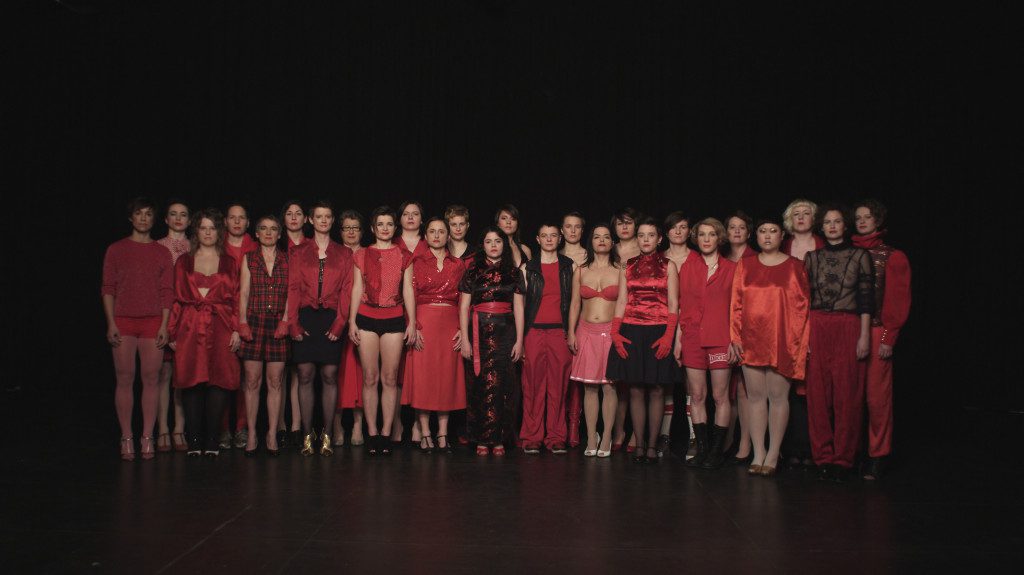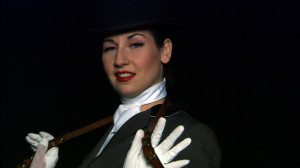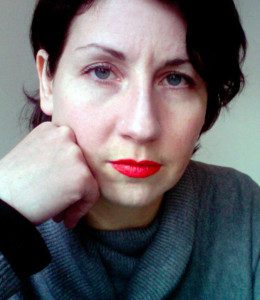《新野蛮滑稽戏》
Nouvelle Burlesque Brutal
2011 | 43min | 卡特琳娜·达什内 Katrina Daschner
实验短片 Experimental Film
编剧 Screenwriter
卡特琳娜·达什内 Katrina Taschner
主演 Cast
卡特琳娜·达什内Katrina Daschner
制片人 Producers
卡特琳娜·达什内 Katrina Daschner, Catrin Seefranz, Katharina Aigner, Karin Haas, Cordula Thym
摄影 Cinematographer
Hannes Böck
对白语言 Language
无 none
字幕 Subtitles
中英 Chinese, English
制作机构 Production Group
Lady Chutney Production
故事梗概 Synopsis
一名风情万种的脱衣舞女与一位上层淑女调情。一个花式骑马师进入了一个类似色情的三角关系,而另两位女人扮演的是马。一盘旋涡状的长篇和一把飞出去的刀在糖果的海洋旋转。围绕着这三部曲的,是一个沉默的、大笑的、欢乐的、激吻的蕾丝酷儿唱诗班。在后情色与新滑稽运动中,酷儿和女性主义者都强调身体影像的多元和操演性,将欲望放在中心。维也纳艺术家卡特琳娜·达什内也是其中之一,她超越了异性恋的凝视,颠覆了有关诱惑的经典语词。当滑稽艺术家在第一部分《海港珍珠》中微笑着使用传统的色情勾引的手势时,她的笑容不再是一种唾手可得的物品。恰恰相反,这直面镜头的狡黠的笑,加上脱衣舞女和观看者之间的眉目传情(二者都由卡特琳娜·达什内扮演),不再是时尚、迷人却枯燥无味的演出。这一笑也给剧末唱诗班的欢笑释放留下了注解。在第二部分《野马咏叹调》和第三部分《燃烧的火烈鸟》中,电影和剧场史上的主题反复出现,感官自主成为了核心。而唱诗班的多变——时而阳刚,时而魅惑——也解释了那一个眼神交换,而最后,所有这些都融汇成了一个充满力量的共同体。
A coquettish stripper flirts with an upper-class lady. A dressage rider jumps into a quasi-pornographic ménage à trois with two women playing a horse. A disc adorned with a spiral and a throwing knife rotatesin a sea of confetti. And a silent, laughing, cheering and kissing lesbian-queer choir surround the trilogy. In the context of post-porn strategies and the neo-burlesque movement, captured (also) by queers and feminists for whom the plurality and performativity of body images and forms of desire are central, the Vienna-based artist Katrina Daschner crosses the heterosexist gaze with an obvious, classical vocabulary of temptation. When the burlesque performer in the first part “Hafenperlen (Harbor Pearls)” smilingly calls up the traditional gestures of an erotic tease, thereby referencing an Egyptian film of the 1940s in which the singer and dancer Naima Akef embodies both the belly dancer as well as the captain flirting with her, her smile is no longer that of an available object. On the contrary, the knowing grin, directly addressed to the camera, together with the complicit winking between the stripper and the observing lady (both played by Daschner), creates a distance from the glamorous and stylish, almost sterile staging of the events, at the same time commenting on the fantasm, as well as the liberating laughter of the lesbian chorus at the end. Also in the second and third parts, “Aria de Mustang” and “Flaming Flamingos,” which allude to recurring motifs in film and theater history with calculated dramatical effects and queer musical undertones by the Kumbia Queers, Bonanza Jellybean and Edita Gruberová, the sensuous self-determination stands at the core, which through the plurality of the chorus, appearing at times androgynous, at times opulent in red drag, comments with a wink of the eye, before finally embedding in a powerful collective.
导演简历 Bio-Filmography of Director
卡特琳娜·达什内出生于德国汉堡,现居奥地利维也纳,视觉艺术家,电影导演。15岁起,她便在各国的艺术空间和酷儿电影节展示其作品。2009年起,她开始在维也纳举办酷儿“野蛮滑稽俱乐部”。2000至2002年间,她开办过一个名为“酸辣酱女士沙龙”的行为艺术空间,并于2005至2010年执教于维也纳美术学院。
Katrina Daschner was born in Hamburg and lives in Vienna. She is a visual artist and filmmaker. For fifteen years, she has shown her work internationally, mostly in exhibition spaces and at (mostly queer) film festivals. Since 2009 she has hosted the queer Club Burlesque Brutal at the Brut Theatre in Vienna. She ran a performance art space called Salon Lady Chutney from 2000 to 2002 and taught visual art at the Academy of Fine Arts in Vienna from 2005 to 2010. Videos/Films (selection): Parole Rosette (2012), Nouvelle Burlesque Brutal (Trilogy, 2011), Flaming Flamingos (2011), Aria de Mustang (2009), Hafenperlen(2008), Dolores (2005), Chutney Mary (2000), Lady Chutney Does México (1999), Mutter mit Marmelade (1998), Gefüllte Gans (1998)
导演阐述 Director’s Statement
我的艺术作品大多是关于(性别)权力机构的,也关注舞台语言到展览空间和电影语境的转化。我试图创造一种视觉语言,它乍看来拥有一种光滑、优雅的外表,因为我认识到(异性恋)人们总是觉得酷儿艺术就应该是一种颓废美学,必须看起来是亚文化的,又不应该吓到他们——换句话说,酷儿艺术就应该呆在它自己的小角落。为了改变这种印象,我尝试着用主流电影语言来拍摄酷儿影像,因为我受够了待在那个小抽屉里
My artistic projects often deal with (gender specific) power structures and the transfer of stage language into the exhibition space and film context. I try to create a visual language which has a slick and elegant look at first sight, as I have recognized that (hetero) people like to see queer topics in more trashy aesthetics, as this might seem more subcultural and not so frightening to them—in other words, that it should stay in that little corner. To change this situation I try to make pictures which take place in dominant film language, as I have had enough of staying in that small little drawer.



